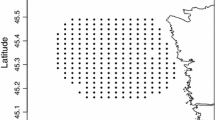Abstract
We introduce a new class of circular time series based on hidden Markov models. These are compared with existing models, their properties are outlined and issues relating to parameter estimation are discussed. The new models conveniently describe multi-modal circular time series as dependent mixtures of circular distributions. Two examples from biology and meteorology are used to illustrate the theory. Finally, we introduce a hidden Markov model for bivariate linear-circular time series and use it to describe larval movement of the fly Drosophila.
Similar content being viewed by others
References
LE Baum T. Petrie (1966) ArticleTitleStatistical inference for probabilistic functions of finite state Markov chains Ann Math Stat. 37 1554–1563
D Best N. Fisher (1979) ArticleTitleEfficient simulation of the von Mises distribution Appl Stat 24 1527
PJ Bickel Y Ritov T. Rydén (1998) ArticleTitleAsymptotic normality of the maximum-likelihood estimator for general hidden Markov models Ann Stat. 26 1614–1635 Occurrence Handle10.1214/aos/1024691255
J. Breckling (1989) The analysis of directional time series: applications to wind speed and direction Springer Verlag Berlin
NI Fisher AJ Lee (1994) ArticleTitleTime series analysis of circular data J Roy Stat Soc Ser B. 56 327–339
NI Fisher AJ. Lee (1983) ArticleTitleA correlation coefficient for circular data Biometrika. 70 327–332 Occurrence Handle10.2307/2335547
MD Fraser YS Hsu JJ. Walker (1981) ArticleTitleIdentifiability of finite mixtures of von Mises distributions Ann Stat. 9 1130–1131
CH Green B Burnet KJ. Conolly (1983) ArticleTitleOrganization and patterns of inter- and intraspecific variation in the behaviour of Drosophila larvae Anim Behav. 31 282–291 Occurrence Handle10.1016/S0003-3472(83)80198-5
P Giudici T Rydén P. Vandekerhove (2000) ArticleTitleLikelihood-ratio test for hidden Markov models Biometrics. 56 742–747 Occurrence Handle10985210 Occurrence Handle1:STN:280:DC%2BD3M%2Fms1yjtg%3D%3D Occurrence Handle10.1111/j.0006-341X.2000.00742.x
RJ. Hathaway (1985) ArticleTitleA constrained formulation of maximum-likelihood estimation for normal mixtures distributions Ann Stat. 13 795–800
H Holzmann A Munk B. Stratmann (2004) ArticleTitleIdentifiability of finite mixtures-with applications to circular distributions Sankhya 66 440–449
SR Jammalamadaka AS. SenGupta (2001) Topics in circular statistics World Scientific Publishing Co New York
RA Johnson TE. Wehrly (1979) ArticleTitleBivariate models for dependence of angular observations and a related Markov process Biometrika. 66 255–2566 Occurrence Handle10.2307/2335667
IL MacDonald W. Zucchini (1997) Hidden Markov and other models for discrete-valued time series Chapman and Hall London
KV. Mardia (1976) ArticleTitleLinear-circular correlation coefficients and rhythmometry Biometrika. 63 403–405 Occurrence Handle10.2307/2335637
KV Mardia P. Jupp (2000) Directional statistics Wiley New York
SL. Scott (2002) ArticleTitleBaysian methods for hidden Markov models: recursive computing in the 21st century J Am Stat Assoc. 97 337–351 Occurrence Handle10.1198/016214502753479464
BD Spurr MA Koutbeiy (1991) ArticleTitleA comparision of various methods for estimating the parameters in mixtures of von Mises distributions Commun stat/Simulat Comput. 20 725–741
Suster ML (2000) Neural control of larval locomotion in Drosophila melanogaster. PhD Thesis, University of Cambridge.
ML Suster JR Martin C Sung S. Robinow (2003) ArticleTitleTargeted expression of tetanus toxin reveals sets of neurons involved in larval locomotion in Drosophila J Neurobiol. 55 233–246 Occurrence Handle12672020 Occurrence Handle1:CAS:528:DC%2BD3sXjslSntrs%3D Occurrence Handle10.1002/neu.10202
Zucchini W, MacDonald IL (1998) Hidden Markov time series models: some computational issues. In: Weisberg S (ed) Computing science and statistics, vol. 30. Interface Foundation of North America, pp 157–163
Author information
Authors and Affiliations
Corresponding author
Additional information
Received: September 2003 / Revised: March 2004
Rights and permissions
About this article
Cite this article
Holzmann, H., Munk, A., Suster, M. et al. Hidden Markov models for circular and linear-circular time series. Environ Ecol Stat 13, 325–347 (2006). https://doi.org/10.1007/s10651-006-0015-7
Issue Date:
DOI: https://doi.org/10.1007/s10651-006-0015-7




